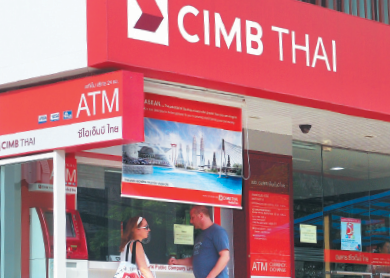
CIMB Group Holdings Bhd is likely to have a weak start to the year, if the first quarter financial results of its Indonesian and Thai banking subsidiaries are any indication.
Higher levels of provision for bad loans in PT Bank CIMB Niaga Tbk and CIMB Thai Bank PCL saw each of them turning in a worse-than-expected performance last week.
This will continue to weigh on CIMB Group’s earnings, say analysts. The group had one of its worst quarterly performances in the fourth quarter of last year, mainly because of high provisions.
CIMB Group (fundamental: 1.05; valuation: 1.65) is expected to announce its first quarter results next month.
“Generally, we expected a weak quarter because of CIMB Niaga,” AllianceDBS says in a research note. “However, the Malaysian business should see a better quarter in the absence of goodwill impairment for the investment banking business and a one-off large provision related to a legacy corporate account that was booked in the fourth quarter of 2014 (4Q2014),” the research house adds.
The Malaysia operation still accounts for the biggest chunk of CIMB Group’s earnings. Indonesia made up 19% of the group’s full-year earnings in 2014, but in better years, it used to be about 30%.
Last Wednesday, CIMB Group’s 97.94%-owned Indonesian bank, CIMB Niaga, reported a 92.4% drop in net profit to IDR83 billion for the first quarter ended March 31, 2015 (1QFY2015). This accounted for just 2% to 3% of analyst consensus estimates for the full year.
The dismal performance was mainly due to a 619.4% year-on-year increase in provision expenses, to IDR1.45 trillion. The provisions were, nevertheless, lower by 26.2% than that in 4Q2014. This helped CIMB Niaga’s net profit rise by 80.4% on a quarter-on-quarter basis from a low base of IDR46 billion in 4Q2014.
In an interview with The Edge last month, CIMB Group CEO Tengku Datuk Zafrul Aziz indicated that CIMB Niaga’s provisions in the first quarter would be lower than in 4Q2014.
“We are hopeful that the second quarter onwards will be better. Nobody can foresee the future [but] we can safely say the fourth quarter [of 2014] is the worst,” he said.
Analysts, however, think provisions will remain high in the second quarter too.
“Provision for loan losses are likely to remain elevated in 2Q2015 but lower than the preceding two quarters,” MIDF Research banking analyst Kelvin Ong says following a results briefing by CIMB Niaga’s management last week.
Given the weaker economic environment, loan growth slowed to 9.6%, while non-interest income fell by 29.4% because of weaker treasury market activities and lower bancassurance fees.
CIMB Niaga’s asset quality continued to deteriorate, with the gross non-performing loan (NPL) ratio rising to 4.1% compared with 2.57% a year ago, and 3.9% as at end-December 2014. Vice-president and director D James Rompas blames this on the tougher economic conditions, volatile rupiah and softer commodity prices.
Nonetheless, some analysts question whether the bank could have fared better if its credit controls in the past had been tighter. About 4% to 5% of CIMB Niaga’s total loan book is exposed to the troubled coal and coal-related segments. Of these, 40% are classified as non-performing.
The coal segment aside, analysts say the bank’s management is also wary of asset quality in the manufacturing sector.
“Management expects the weak operating environment to persist into 2Q2015 and guides for ongoing net interest margin (NIM) compression. Provisioning levels are expected to remain elevated in 2Q2015, but management does not expect the gross NPL ratio to breach 5%,” Maybank Investment Bank Research’s Desmond Ch’ng says in a note to clients last Thursday.
“While we think that our provisioning assumptions are sufficiently conservative, the operating environment has been weaker than expected. Cutting our NIM and non-interest income assumptions, we downgrade CIMB Niaga’s FY2015 and FY2016 net profit forecasts by 23% and 11% [respectively], with an estimated 6% and 3% impact on CIMB Group’s earnings,” he adds.
Meanwhile, last Tuesday, the group’s 93.71%-owned Thai bank, CIMB Thai, reported a 70.4% slump in first quarter net profit to THB130.6 million. This accounted for only 15% of analysts’ full-year forecast.
Unlike CIMB Niaga, however, CIMB Thai’s contribution to CIMB Group is small, at less than 3%.
“CIMB Thai’s results are reflective of the still challenging economic environment prevalent in the country, evidenced by the 117.6% year-on-year spike in provisions,” says PublicInvest Research. The provision was 41.9% higher than that in the preceding quarter.
CIMB Thai’s loan growth was a tepid 2.7%. Gross NPL worsened to 3.7% from 3.3% as at end-December due to lower repayments from several corporate accounts.
Just last Monday, Public Bank Bhd kicked off the reporting season for the January-March quarter among banks. Despite a tougher operating environment, the banking group turned in a 15% rise in net profit to
RM1.17 billion, which was within analysts’ expectations.
Maybank IB Research cut its call on CIMB Group to “sell” from “hold”, but kept its target price at RM5.70 pending the release of its results. According to Bloomberg data, most analysts have a “hold” call on the stock.
The stock, which has gained 10.4% this year, closed at RM6.09 last Friday.

Note: The Edge Research’s fundamental score reflects a company’s profitability and balance sheet strength, calculated based on historical numbers. The valuation score determines if a stock is attractively valued or not, also based on historical numbers. A score of 3 suggests strong fundamentals and attractive valuations. Visit www.theedgemarkets.com for more details on a company’s financial dashboard.
This article first appeared in The Edge Malaysia Weekly, on April 27 - May 3, 2015.
Save by subscribing to us for your print and/or digital copy.
P/S: The Edge is also available on Apple's AppStore and Androids' Google Play.